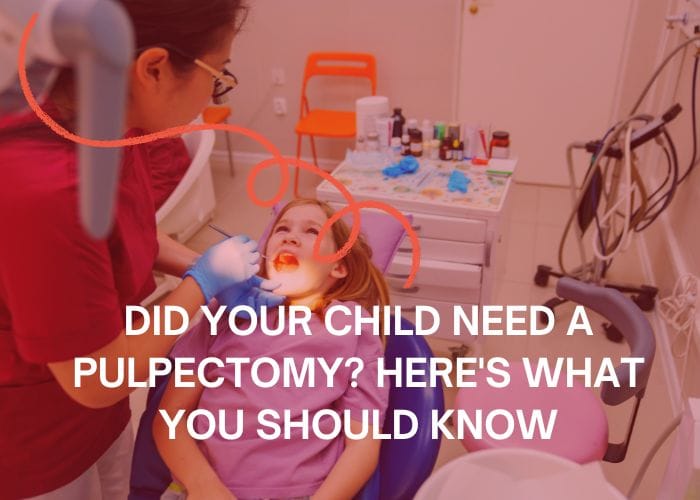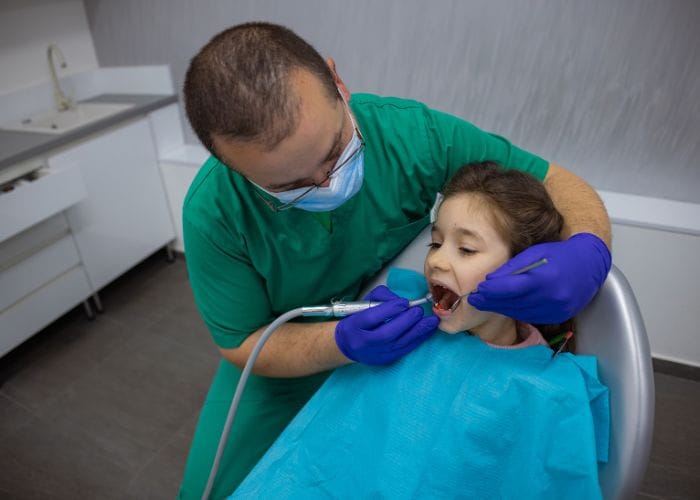

A pulpectomy for kids, often referred to as a baby root canal, is an important procedure in pediatric dentistry used to treat severely infected primary teeth. This procedure involves removing the entire pulp from a tooth to relieve pain and prevent further problems.
It’s crucial to address dental issues in children quickly for their overall health and well-being. Early treatment can stop severe infections, keep the tooth structure intact, and avoid more invasive procedures like extractions. Taking care of your child’s dental health through prompt treatment helps them eat, speak, and develop properly.


A pulpectomy is a dental procedure aimed at treating severely infected primary (baby) teeth. Often referred to as a “baby root canal,” it involves removing the entire pulp from the tooth to alleviate pain and prevent further complications. This procedure plays a crucial role in preserving primary teeth, which are essential for maintaining proper spacing for permanent teeth, aiding in chewing, and facilitating clear speech.
Understanding the dental pulp is key to grasping why a pulpectomy may be necessary. The Dental Pulp is the innermost part of the tooth containing nerves, blood vessels, and connective tissue. It serves several critical functions:
While both pulpectomy and tooth extraction aim to address severe dental issues, they serve different purposes:
By understanding these aspects, you can better appreciate the significance of pulpectomy in pediatric dentistry.
A pulpectomy becomes necessary when a child’s tooth pulp becomes severely infected or damaged. The main causes include:
Identifying the symptoms early can help you seek timely dental care for your child. Key indicators of pulp damage include:
Recognizing these signs and understanding their implications can help you ensure your child’s dental health remains optimal. Always consult with a pediatric dentist if you notice any of these symptoms.
Pulpectomy for kids involves a meticulous process designed to alleviate pain and preserve the affected tooth. Here’s a step-by-step breakdown of what you can expect during the procedure:
The dentist begins by numbing the area around the infected tooth with a local anesthetic. This ensures your child feels no discomfort during the procedure.
A dental dam, which is a small rubber sheet, is placed around the tooth to keep it dry and free from saliva. This isolation is crucial for maintaining a clean and controlled environment during the procedure.
Using specialized dental tools, the dentist removes any decay from the tooth. An opening is then made to access the inner pulp chamber and root canals.
The infected or damaged pulp, which consists of nerves, blood vessels, and connective tissue, is carefully removed from both the pulp chamber and root canals.
The now-empty pulp chamber and root canals are thoroughly cleaned and disinfected to eliminate any remaining bacteria and prevent reinfection.
After disinfection, the cleaned area is filled with a biocompatible material that seals off the space, preventing future infections. Common materials include gutta-percha or resorbable pastes suitable for primary teeth.
In many cases, a crown or filling will be placed on top of the treated tooth to restore its function and appearance.
The entire process typically takes place in one visit, although follow-up appointments may be necessary to monitor healing and ensure long-term success.
Pulpectomies, while effective, do carry certain risks. Complications of pulpectomy in kids can vary, but being aware of potential issues can help you prepare and take preventive measures.
Potential Complications:
Understanding these risks ensures that you stay vigilant post-procedure and consult your dentist promptly if any concerns arise.
When dealing with pulp damage in primary teeth, there may be other treatment options besides pulpectomy that can be considered for kids. These alternatives can be less invasive or more suitable depending on the specific situation.
This procedure involves placing a protective dressing over an exposed pulp due to decay or injury. The goal is to maintain the vitality of the tooth, allowing the pulp to heal naturally.
In cases where the tooth is severely damaged and cannot be salvaged through pulpectomy, extraction might be necessary. This procedure involves removing the affected tooth entirely, which can then be followed by space maintenance to ensure proper alignment of remaining teeth.
Both methods aim to address pulp damage while considering the overall dental health and future development of your child’s oral structure.
Emphasizing the importance of pediatric dental health is crucial. Pulpectomy for kids can be a vital procedure to preserve primary teeth and prevent further complications. Regular dental check-ups and maintaining good oral hygiene can significantly reduce the need for such interventions. If you notice any signs of pulp damage, such as severe tooth pain or sensitivity, seek professional dental care promptly. By taking proactive steps, you ensure your child’s overall dental well-being and set the foundation for a healthy smile in the future.

WhatsApp us